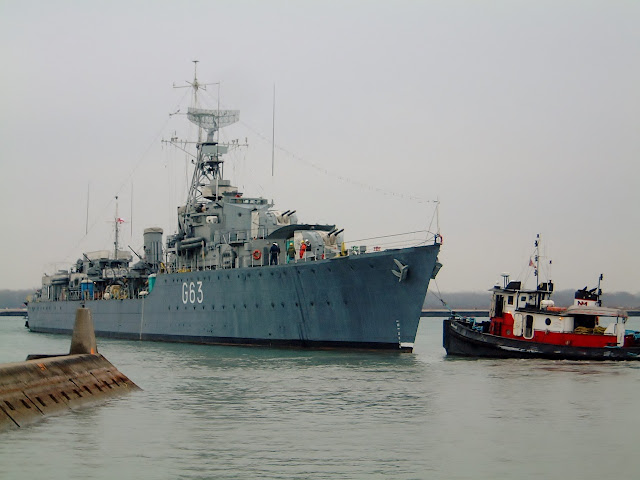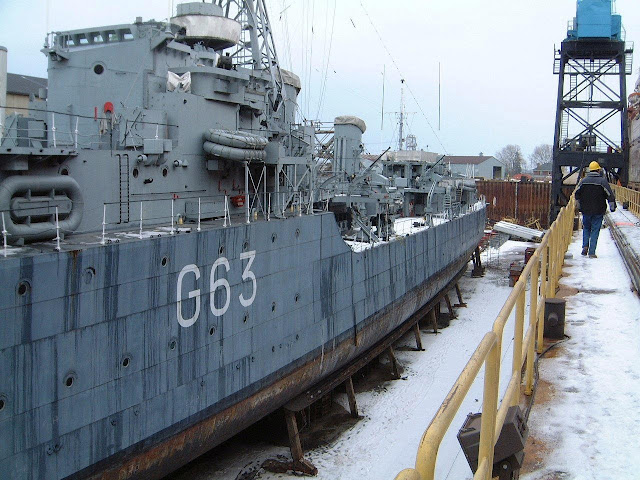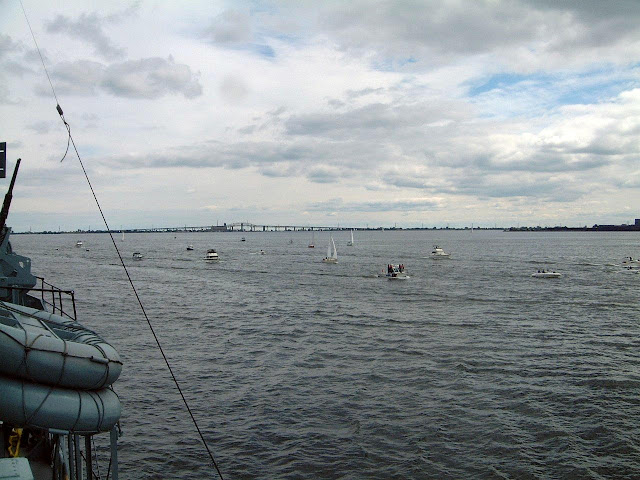The Tribal-class destroyer HMCS Haida is the last remaining example of her class of 27 vessels built for the Royal Navy (16), Royal Canadian Navy (8), and Royal Australian Navy (3) between 1936 and 1945. These powerful fleet destroyers saw much action during the Second World War and the Korean War before being retired from service by the mid-1960s. Having earned the nickname of "Canada's fightingest ship" as a result of sinking more enemy surface tonnage than any other Canadian warship during the Second World War, HMCS Haida was saved from the scrapyard through the efforts of a group of Toronto businessmen and retired naval officers. Preserved as a museum in Toronto in 1964, Haida was acquired by the Ontario provincial government in 1970 and moved to the new Ontario Place recreational complex on the Toronto lakefront.
For the next 32 years, HMCS Haida served as a museum ship and sea cadet training camp; however, given the deteriorating condition of the ship, the Government of Canada acquired the ship in November 2002 and Haida became the responsibility of Parks Canada as a National Historic Site. The Government of Canada's acquisition of Haida came with $5 million for a refit and a commitment to relocate the ship to Hamilton, home of Sheila Copps, the Liberal MP and Minister of Canadian Heritage at the time. To extricate HMCS Haida from the enclosed lagoon at Ontario Place, contractors excavated a channel through a causeway to gain access to Lake Ontario. Haida was then towed out into the lake and west to Port Weller, Ontario for a refit at Port Weller Dry Docks. With the refit completed in 2003, Haida was towed to Hamilton harbour for an extravagant welcoming ceremony attended by thousands of people before being towed to her new home adjacent to the city's naval reserve division facility.
The photos below detail HMCS Haida's departure from Toronto on 11 December 2002; a visit to see Haida under refit at Port Weller Dry Docks on 2 February 2003; and the destroyer's triumphant entry into Hamilton harbour on 30 August 2003, as seen from onboard.
 |
| HMCS Haida berthed at Ontario Place in Toronto in November 2002, following the end of her last season open to the public here. This jetty was Haida's home from 1970 until 11 December 2002, when she was towed across Lake Ontario for a refit and eventual relocation as a National Historic Site in Hamilton, Ontario. |
 |
| After extensive excavation of the causeway that enclosed the Ontario Place lagoon in which HMCS Haida had resided since 1970, work nears completion on cutting the channel that will allow ship to be towed out into Lake Ontario. Photo taken mid-November 2002. |
 |
| On 11 December 2002, Burlington, Ontario-based McKeil Marine's 10-tonne, bollard-pull harbour towing tug Vac prepares to commence towing HMCS Haida out of the Ontario Place lagoon. |
 |
| Spectators brave the cold, damp weather to watch as HMCS Haida prepares to depart its Toronto berth. |
 |
| The tug Vac gently manoeuvres HMCS Haida away from the concrete jetty and towards the centre of the channel cut through the causeway that previously enclosed the lagoon. |
.jpg) |
| HMCS Haida is slowly towed through the recently-excavated narrow channel. |
 |
| With a towing crew aboard, HMCS Haida is pulled backward into Lake Ontario. |
%20%232%20(2).jpg) |
| HMCS Haida afloat in Lake Ontario for the first time since 1970. |
 |
| In conjunction with the tug Vac at Haida's stern, the 10-tonne, bollard-pull tug Seahound at Haida's bow helps helps manoeuvre the destroyer past the concrete breakwater off Toronto's lakeside Coronation Park. |
 |
| Towed by the two McKeil Marine tugs, HMCS Haida commences its slow, six-hour journey from Toronto to Port Weller Dry Docks in Port Weller, Ontario for a major refit. |
 |
| HMCS Haida under refit at Port Weller Dry Docks on 2 February 2003. This was the same dockyard that had last refitted Haida in 1969, prior to her move to Ontario Place. |
 |
| Looking down onto Haida from an adjacent gantry. Canvas covers protect against the ingress of water into the funnel casings. The ship's quadruple torpedo mounting sits on the deck aft of the second funnel. |
.jpg) |
| HMCS Haida rests on a series of timber blocks in the dry dock. |
 |
| A view of Haida's port side from the catwalk along the edge of the dry dock. |
 |
| Looking forward along Haida's port side. A large metal screen has been installed in front of the bow to protect shipyard workers from wind. |
 |
| Looking aft along Haida's starboard side. The destroyer is dwarfed by the 23,054-gross tonne self-unloading bulk carrier MV Atlantic Huron, under refit in the adjacent dry dock. |
 |
| Looking down into the dry dock at Haida's stern. Her propellers had been removed decades previously and were installed on pedestals alongside the ship at Ontario Place. They were subsequently relocated to Hamilton with Haida for display alongside the ship at its new home. |
 |
| Looking up at Haida's port side from the base of the dry dock. The refit at Port Weller Dry Docks in 2003 included replacement of sections of degraded hull plating to ensure the watertight integrity of the hull. |
 |
| A group of former Haida volunteers and summer staff stand under Haida's stern during the visit to the dry dock on 2 February 2003. The ship's size is well illustrated in this photo. |
 |
| Another view of Haida's stern, showing the rudder and twin propeller shafts. |
 |
| Looking aft from Haida's cable deck. Seen are the ship's main armament of two twin 4-inch high-angle/low-angle gun mountings, as well as the glass windscreen of the open bridge. |
 |
| A starboard side view of Haida in dry dock. |
 |
| A stern view from one end of the dry dock, 2 February 2003. The refit of HMCS Haida cost $3.5 million. |
 |
| The refitted HMCS Haida, sporting a fresh coat of paint and her post-1952 pennant number of 215, berthed at Pier 26 in Hamilton harbour on 30 August 2003. The ship had been towed here from Port Weller Dry Docks to await the official celebration welcoming Haida to her new home of Hamilton, Ontario. |
 |
| A view from the bow of HMCS Haida on 30 August 2003. |
 |
| Decked out in celebratory signal flags, Haida prepares to be towed to the celebrations. |
 |
| Members of the Friends of HMCS Haida charitable group prepare to raise the White Ensign from the stern jack staff. |
 |
| The White Ensign flies from the stern of HMCS Haida. It was under this ensign that the destroyer operated during her 20-year career in the Royal Canadian Navy between 1943 and 1963. |
 |
| As HMCS Haida is configured with the structural modifications, weapons, and sensors that were installed during her 1950-52 refit to become a destroyer escort (DDE), it was appropriate and historically accurate to return her post-1952 pennant number of 215 as part of the 2003 refit. The 'G63' previously painted on Haida's sides and stern was her pennant number from 1943 to 1950, when the ship earned her reputation as Canada's "fightingest ship" for sinking the most enemy surface tonnage of any ship in the Royal Canadian Navy. |
 |
| The view from B-gun deck aboard HMCS Haida as she is towed from Pier 26 to a position off of Hamilton's Bayfront Park for the official welcoming ceremony. |
 |
| A flotilla of small boats escort HMCS Haida through Hamilton harbour towards Bayfront Park. |
 |
| The Royal Canadian Navy Kingston-class Maritime Coastal Defence Vessels HMCS Glace Bay (701) and HMCS Shawinigan (704) anchored off Haida's port side for the ceremonies. |
 |
| The crew of HMCS Shawinigan line the ship's rails to salute HMCS Haida. |
 |
| Crowds along the shoreline at Bayfront Park to witness the ceremonies welcoming HMCS Haida to Hamilton, which included a parade of former Haida crew, a flypast of vintage aircraft, historical exhibits, music, and a gun salute fired by the volunteer gunners manning Haida's B-gun. |
 |
| Following the ceremonies at Bayfront Park, Haida is towed a short distance east to her new home next to HMCS Star, Hamilton's naval reserve division. |
 |
| HMCS Haida mooring at her new permanent home at Pier 9, alongside HMCS Star in Hamilton. |



.jpg)

%20%232%20(2).jpg)


.jpg)


























